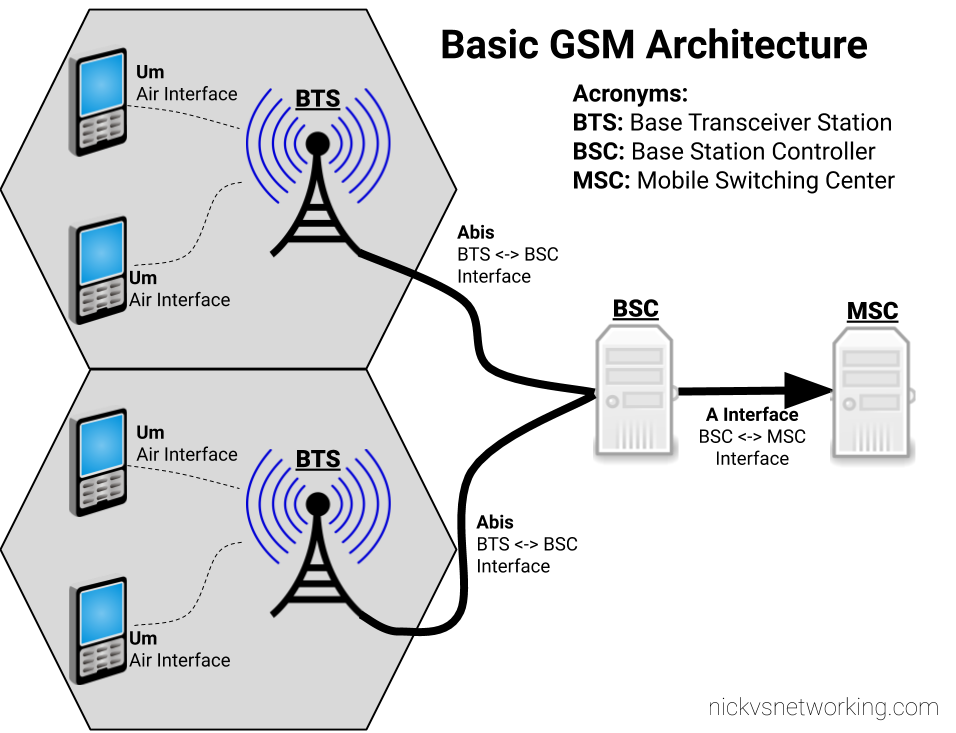So this series of posts will focus on using Osmocom software to create a GSM network, so let’s get some Osmocom software installed, and talk about how we run and configure each network element / node.
Osmocom Packages
For this tutorial series I’ll be using Ubuntu 18.04 and trying where possible to use packages from Repos instead of compiling from source.
This will get the Osmocom key added to your package manager and the Osmocom sources in apt ready for us to install.
wget https://download.opensuse.org/repositories/network:/osmocom:/latest/Debian_10/Release.key apt-key add Release.key && rm Release.key echo "deb https://download.opensuse.org/repositories/network:/osmocom:/latest/xUbuntu_18.04/ ./" > /etc/apt/sources.list.d/osmocom-latest.list apt-get update
Osmo-BTS-Virtual
To get started we’ll install a virtual BTS. This virtual BTS won’t simulate the Um (air) interface, but it will simulate the Abis interface towards the BSC so we can configure this virtual BTS in our BSC.
Installation is pretty straightforward:
apt-get install osmo-bts-virtual
By default Osmocom software runs as a daemon in systemctl, we’ll disable and stop this behaviour for now so we can better understand it running in the foreground:
systemctl stop osmo-bts-virtual systemctl disable osmo-bts-virtual
Osmo Config – Text Files
If you have a look in /etc/osmocom/ you’ll see .cfg files that contain our config in text files.
But that’s not the only way (or even the recommended way) that we’ll put together the config for Osmocom software, but we’ll get started by editing the config file manually.
We’ll start by setting a Unit ID of the BTS and setting the IP of the BSC.
cd /etc/osmocom/ vi osmo-bts-virtual.cfg
We’ll edit the oml remote-ip to point to the IP of the server that will run our BSC, if you’re planning on running the BTS and BSC on the same machine you can leave it as localhost (127.0.0.1).
Next up we’ll set the Unit-ID of the BTS, this identifies the BTS inside the BSC,
I’ll set it to unit-id 4242 by changing ipa unit-id 4242 0
Finally we’ll change the logging config to show everything by changing it to:
log stderr logging filter all 1 !
So that’s it in terms of config for our virtual BTS through text files, so we’ll save the file and try starting up osmo-bts-virtual.
osmo-bts-virtual -c osmo-bts-virtual.cfg
You should get a result similar to this:
root@gsm-bts:/etc/osmocom# osmo-bts-virtual -c osmo-bts-virtual.cfg ((*)) | / \ OsmoBTS <0010> telnet_interface.c:104 Available via telnet 127.0.0.1 4241 <0012> input/ipaccess.c:901 enabling ipaccess BTS mode, OML connecting to 127.0.0.1:3002 <000d> abis.c:142 Signalling link down <0001> bts.c:292 Shutting down BTS 0, Reason Abis close Shutdown timer expired root@gsm-bts:/etc/osmocom#
So what are we seeing here?
Well Osmo-BTS-Virtual is trying to bring up it’s Abis interface but it’s not getting a connection to the the BSC (We haven’t set one up yet). No connection to a BSC means the BTS won’t go on the air as it doesn’t have any processing for itself, so it eventually times out and shuts down.
In the next post we’ll move from using osmo-bts-virtual to using a SDR to run Osmo-BTS. If you’re using commercial RAN hardware, or just playing along without any RAN, skip straight to the post on Base Station Controllers where we’ll pick up again adding our Virtual BTS to the BSC.
